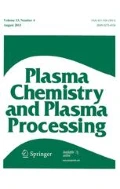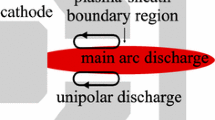Abstract
Analysis of the plasma parameters of a tungsten-inert gas microarc with a length of 0.4 mm is carried out by means of a unified one-dimensional model. The model solves the fluid equations for the particle and energy conservation of the electrons and the heavy species in the plasma, and the heat conduction in the thermionic cathode. The particle transport of the electrons and the ions is coupled with the Poison’s equation. The spatial distributions of the densities of the charged particles, the electric potential and field, the components of the electric current density, the heating mechanisms and the resulting temperatures of the electrons and heavy particles are discussed in detail for an electric current density of 106 A/m2. The discharge voltage, estimates of the Debye length, the near-electrode voltage drop, and the thickness of the regions of space charge adjacent to the electrodes are obtained for current densities in the range from 5.3 × 103 up to 2.3 × 106 A/m2.









Similar content being viewed by others
References
Schoenbach KH, Becker K (2016) 20 years of microplasma research: a status report. Eur Phys J D 70:29
Becker K, Schoenbach KH, Eden JG (2006) Microplasmas and applications. J Phys D Appl Phys 39:R55–R70
Kushner MJ (2004) Modelling of microdischarge devices: pyramidal structures. J Appl Phys 95:846–859
Boeuf JP, Pitchford LC, Schoenbach KH (2005) Predicted properties of microhollow cathode discharge in xenon. Appl Phys Lett 86:071501
Farouk T, Farouk B, Gutsol A, Fridman A (2008) Atmospheric pressure radio frequency glow discharges in argon: effects of external matching circuit parameters. Plasma Sources Sci Technol 17:035015
Dufour T, Overzet LJ, Dussart R, Pitchford LC, Sadeghi N, Lefaucheux P, Kulsreshath M, Ranson P (2010) Experimental study and simulation of a micro-discharge with limited cathode area. Eur Phys J D 60:565–574
Bruggeman P, Brandenburg R (2013) Atmospheric pressure discharge filaments and microplasmas: physics, chemistry and diagnostics. J Phys D Appl Phys 46:464001
Park M, Hirata Y, Urabe T (2014) Development of controlled micro-discharge at the atmospheric pressure. Weld World 58:47–54
Eliseev SI, Kudryavtsev AA, Liu H, Ning Z, Yu D, Chirtsov AS (2016) Transition from glow microdischarge to arc discharge with thermionic cathode in argon at atmospheric pressure. IEEE Trans Plasma Sci 44:2536
Saifutdinov AI, Fairushin II, Kashapov NF (2016) Analysis of various scenarios of the behavior of voltage–current characteristics of direct-current microdischarge at atmospheric pressure. JETP Lett 104:180–185
Baeva M (2017) A survey of chemical nonequilibrium in argon arc plasma. Plasma Chem Plasma Process 37(3):513–550
Shirvan AJ, Choquet I (2016) A review of cathode-arc coupling in GTAW. Weld World 60:821–835
Lisnyak M, Cunha MD, Bauchire J-M, Benilov MS (2017) Numerical modelling of high-pressure arc discharges: matching the LTE arc core with the electrodes. J Phys D Appl Phys 50:315203
Li H-P, Benilov MS (2007) Effect of a near-cathode sheath on heat transfer in high-pressure arc plasmas. J Phys D Appl Phys 40:2010–2017
Baeva M, Benilov MS, Almeida NA, Uhrlandt D (2016) Novel non-equilibrium modelling of a DC electric arc in argon. J Phys D Appl Phys 49:245205
Almeida NA, Benilov MS, Naidis GV (2008) Unified modelling of near-cathode plasma layers in high-pressure arc discharges. J Phys D Appl Phys 41:144001
Semenov IL, Krivtsun IV, Reisgen U (2016) Numerical study of the anode boundary layer in atmospheric pressure arc discharges. J Phys D Appl Phys 49:105204
Khrabry A, Kaganovich ID, Nemchinsky V, Khodak A (2018) Investigation of the short argon arc with hot anode. I. Numerical simulations of non-equilibrium effects in the near-electrode regions. Phys Plasmas 25:013521
Baeva M, Loffhagen D, Becker MM, Uhrlandt D (2019) Fluid modelling of DC argon microplasmas: effects of the electron transport description. Plasma Chem Plasma Process 39:949–968
Hayashi M (2003) Bibliography of electron and photon cross sections with atoms and molecules published in the 20th century. Argon, NIFS-DATA-72 Report
Vriens L, Smeets AHM (1980) Cross-section and rate formulas for electron-impact ionization, excitation, deexcitation, and total depopulation of excited atoms. Phys Rev A 22:940–951
Flannery MR, McCann KJ (1980) Cross sections for ionization of rare gas excimers by electron impact and atomic and molecular processes in excimer lasers. Technical Report AFWAL-TR-80-2015
Cunningham AJ, O’Malley TF, Hobson RM (1981) On the role of vibrational excitation in dissociative recombination. J Phys B At Mol Phys 14:773–782
Marchenko VS (1983) Dissociation of homonuclear ions by electron impact. Sov Phys JETP 58:292–298
Raizer YP (1991) Gas discharge physics. Springer, New York
Kolokolov NB, Kudrjavtsev AA, Blagoev AB (1994) Interaction processes with creation of fast electrons in the low temperature plasma. Phys Scr 50:371–402
Lymberopoulos DP, Economou DJ (1993) Fluid simulations of glow discharges: effect of metastable atoms in argon. J Appl Phys 73:3668–3679
Lam SK, Zheng C-E, Lo D, Dem’ynov A, Napartovoch AP (2000) Kinetics of Ar2* in high-pressure pure argon. J Phys D Appl Phys 33:242–251
Kannari F, Suda S, Obara M, Fujioka T (1983) Theoretical simulation of electron-beam-excited xenon-chloride (XeCl) lasers. IEEE J Quantum Electron 19:1587–1600
Biberman LM, Vorob’ev VS, Yakubov IT (2012) Kinetics of nonequilibrium low-temperature plasmas. Springer, Berlin
Kramida A, Ralchenko Y, Reader J, NIST ASD Team (2018) NIST Atomic Spectra Database
Gregorio J, Leprince P, Bolsse-Laporte C, Alves LL (2012) Self-consistent modelling of atmospheric micro-plasmas produced by a microwave source. Plasma Sources Sci Technol 21:015013
Bretagne J, Godart J, Puech V (1982) Low-energy electron distribution in an electron-beam generated argon plasma. J Phys D Appl Phys 15:2205–2225
Zhou W, Guo H, Jiang W, Li H-P, Li Z-Y, Lapenta G (2016) Particle-in-cell and Monte Carlo collision simulations of the cathode sheath in an atmospheric direct-current arc discharge. Plasma Source Sci Technol 25:05LT01
Beulens JJ, Milojevic D, Schram DC, Vallinga M (1991) A two-dimensional nonequilibrium model of cascaded arc plasma flows. Phys Fluids 3:2548–2557
Bird RR, Steward WE, Lightfoot EN (2002) Transport phenomena. Wiley, Hoboken
Chase MW Jr (1998) NIST-JANAF thermochemical tables (Journal of Physical and Chemical Reference Data), 4th edn. ACS Publications, Washington
Gurvich LV, Veyts IV, Alcock CB (1989) Thermodynamic properties of individual substances, vol 1, Part 2 Tables, 4th edn. Hemisphere Publishing Corp., Washington
Neufeld PD, Janzen AR, Aziz RA (1972) Empirical equations to calculate 16 of the transport collision integrals Ω(l,s)* for the Lennard-Jones (12–6) potential. J Chem Phys 57:1100–1102
Brokaw RS (1969) Predicting transport properties of dilute gases. Ind Eng Process Des Dev 8:240–253
Incropera FP, DeWitt DP, Bergmann TL, Lavine AS (2007) Fundamentals of heat and mass transfer. Wiley, New York
Blanket, Shield Design and Material Database (1991) ITER Documentation Series No. 29. IAEA, Vienna
Touloukian YS, Powell RW, Ho CY, Clemens PG (1970) Thermal conductivity: metallic elements and alloys (thermophysical properties of matter), vol 1. Plenum Press, New York
Arslanbekov RR, Kolobov VI (2003) Two-dimensional simulations of the transition from Townsend to glow discharge and subnormal oscillations. J Phys D Appl Phys 36:2986–2994
Dushman S (1930) Thermionic emission. Rev Mod Phys 2:381–476
Fomenko VS (1981) Electron emission properties of materials. Naukova Dumka, Kiev
COMSOL Mupltiphysics® v. 5.4. User guide. COMSOL, Stockholm
Tonks L, Langmuir I (1929) A general theory of the plasma of an arc. Phys Rev 34:876–922
Franklin RN (2003) The plasma-sheath boundary region. J Phys D Appl Phys 36:R309–R320
Allen JE (2009) The plasma-sheath boundary: its history and Langmuir’s definition of the sheath edge. Plasma Sources Sci Technol 18:014004
Brinkmann RP (2007) Beyond the step model: approximate expressions for the field in the plasma boundary sheath. J Appl Phys 102:093303
Baeva M (2017) Non-equilibrium modeling of tungsten-inert gas arcs. Plasma Chem Plasma Process 37:341–370
Amakawa T, Jenista J, Heberlein J, Pfender E (1998) Anode-boundary-layer behaviour in a transferred, high-intensity arc. J Phys D Appl Phys 31:2826–2834
Graves DB, Jensen KF (1986) A continuum model of DC and RF discharges. IEEE Trans Plasma Sci 14:78–91
Long WK (1979) Plasma sheath processes. Technical Report AFAPL-TR-2038
Acknowledgements
The work of M. Baeva is funded by the Deutsche Forschungsgemeinschaft (DFG, German Research Foundation)—Project Number 390828847.
Author information
Authors and Affiliations
Corresponding author
Additional information
Publisher's Note
Springer Nature remains neutral with regard to jurisdictional claims in published maps and institutional affiliations.
Appendix: Derivation of the expression of the heat flux Q c to the cathode
Appendix: Derivation of the expression of the heat flux Q c to the cathode
For the sake of a simple and a feasible derivation, we consider only the presence of atomic ions in the vicinity of the cathode and follow the procedure described in [16]. The results presented in “Results and Discussion” section show that this assumption is well justified.
At stationary conditions and taking into account the plasma-reaction model in Table 1, the source terms in Eqs. (1) and (3) can be written as
where Rj denotes the rate coefficients of the reaction of number j in Table 1. Then, it follows from Eqs. (1), (3), (13) and (14) that
Next, we separate \(S_{\varepsilon }\) into two parts—the one resulting from net ionization and the other—from net excitation. The latter is associated with the radiation losses. Adding up the stationary parts of Eqs. (2) and (5), we can write the following relation.
After multiplying Eq. (15) by − e(Eion − W) and adding it up to Eq. (16), we get
We consider now the left-hand-side of Eq. (17), representing the divergence of the heat flux Qc due to the transport of energy of electrons and heavy particles, together with the boundary conditions in Table 2 and accounting for that the positive x-direction from the plasma to the cathode (Fig. 1). Further, we recall that Eqs. (5) and (6) are solved for the variable T and the conductive flux (q) from the plasma to the cathode is already implicitly considered. After some rearrangements and replacing \(\epsilon_{th}\) and \(\epsilon_{se}\), the result reads
In Eq. (17), the particle fluxes of secondary and thermionic electrons are replaced by the corresponding current densities \(j_{se}\) and \(j_{em}\). Equation (17) includes so far contributions from the plasma. In order to account for a cooling of the cathode by black-body radiation, an additional term \(- \epsilon_{W} \sigma_{SB} T_{c}^{4}\) is added to right-hand-side of Eq. (17) to obtain the expression of Qc in Table 2.
Rights and permissions
About this article
Cite this article
Baeva, M., Loffhagen, D. & Uhrlandt, D. Unified Non-equilibrium Modelling of Tungsten-Inert Gas Microarcs in Atmospheric Pressure Argon. Plasma Chem Plasma Process 39, 1359–1378 (2019). https://doi.org/10.1007/s11090-019-10020-x
Received:
Accepted:
Published:
Issue Date:
DOI: https://doi.org/10.1007/s11090-019-10020-x




